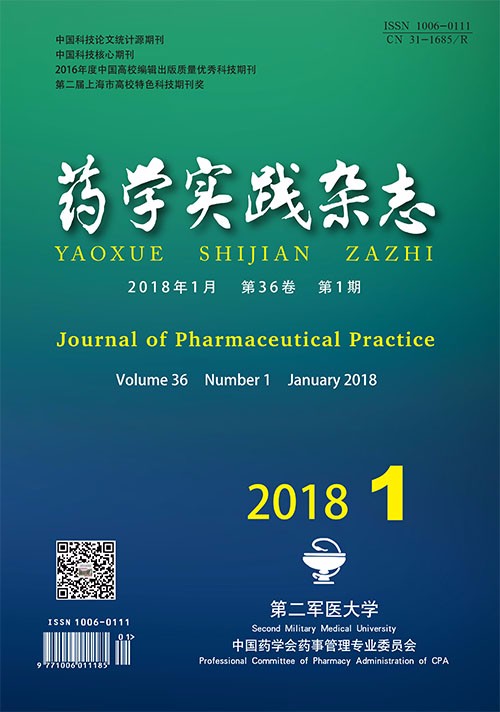|
[1]
|
Mandal B, Bhattacharjee H, Mittal N, et al. Core shell-type lipid polymer hybrid nanoparticles as a drug delivery platform[J]. Nanomedicine, 2013, 9(4):474-491. |
|
[2]
|
Hadinoto K, Sundaresan A, Cheow WS. Lipid polymer hybrid nanoparticles as a new generation therapeutic delivery platform:a review[J].Eur J Pharm Biopharm, 2013, 85(3Pt A):427-443. |
|
[3]
|
赵一擎, 刘颖, 冯年平. 脂质聚合物纳米粒的研究进展[J]. 华西药学杂志, 2014, 29(5):602-605. |
|
[4]
|
王盈. 载溶酶体的脂质-聚合物杂化纳米粒的制备、表征和胶体稳定性评价[J]. 中国医药工业杂志,2016,47(11):1453. |
|
[5]
|
Chan JM, Zhang L, Yuet KP, et al. PLGA-lecithin-PEG core-shell nanoparticles for controlled drug delivery[J]. Biomaterials, 2009, 30(8):1627-1634. |
|
[6]
|
杨龙, 陈凌云, 魏刚. 眼用脂质纳米制剂的研究进展[J]. 中国医药工业杂志, 2016, 47(12):1592-1599. |
|
[7]
|
Zhang L, Zhu D, Dong X, et al. Folate-modified lipid-polymer hybrid nanoparticles for targeted paclitaxel delivery[J].Int J Nanomedicine,2015, 10:2101-2114. |
|
[8]
|
Almeida H, Amaral MH, Lob o P, et al. Applications of poloxamers in ophthalmic pharmaceutical formulations:an overview[J].Expert Opin Drug Deliv, 2013, 10(9):1223-1237. |
|
[9]
|
Bucolo C, Drago F, Salomone S. Ocular drug delivery:a clue from nanotechnology[J].Front Pharmacol, 2012, 3(3):188. |
|
[10]
|
蒋敏, 甘莉, 甘勇, 等. 新型眼用脂质载体制剂的研究进展[J]. 中国药学杂志, 2012, 47(16):1265-1270. |
|
[11]
|
Diebold Y, Jarrín M, Saez V, et al. Ocular drug delivery by liposome-chitosan nanoparticle complexes (LCS-NP)[J]. Biomaterials, 2007, 28(8):1553-1564. |
|
[12]
|
Gan L, Wang J, Zhao Y, et al. Hyaluronan-modified core shell liponanoparticles targeting CD44-positive retinal pigment epithelium cells via intravitreal injection[J]. Biomaterials, 2013, 34(24):5978-5987. |
|
[13]
|
Lim SS, Vos T, Flaxman AD, et al. A comparative risk assessment of burden of disease and injury attributable to 67 risk factors and risk factor clusters in 21 regions, 1990-2010:a systematic analysis for the Global Burden of Disease Study 2010[J]. Lancet, 2012, 380(9859):2224-2260. |
|
[14]
|
Krishnamurthy S, Vaiyapuri R, Zhang L, et al. Lipid-coated polymeric nanoparticles for cancer drug delivery[J].Biomater Sci, 2015, 3(7):923-936. |
|
[15]
|
Lu Y, Low PS. Folate-mediated delivery of macromolecular anticancer therapeutic agents.[J]. Adv Drug Deliv Rev, 2002, 54(5):675-693. |
|
[16]
|
Shen Z, Loe DT, Awino JK, et al. Self-assembly of core-polyethylene glycol-lipid shell (CPLS) nanoparticles and their potential as drug delivery vehicles[J]. Nanoscale, 2016, 8(31):14821-14835. |
|
[17]
|
Wang F, Chen L, Zhang R, et al. RGD peptide conjugated liposomal drug delivery system for enhance therapeutic efficacy in treating bone metastasis from prostate cancer[J]. J Control Release, 2014, 196:222-233. |
|
[18]
|
Shi K, Zhou J, Zhang Q, et al. Arginine-glycine-aspartic acid-modified lipid-polymer hybrid nanoparticles for docetaxel delivery in glioblastoma multiforme[J]. J Biomed Nanotechnol, 2015, 11(3):382-391. |
|
[19]
|
Zhao Y, Lin D, Wu F, et al. Discovery and in vivo evaluation of novel RGD-modified lipid-polymer hybrid nanoparticles for targeted drug delivery[J]. Int J Mol Sci, 2014, 15(10):17565-17576. |
|
[20]
|
张悦, 邢仕歌, 王震, 等. 核酸适配体在靶向药物传递中的研究进展[J]. 生物化学与生物物理进展, 2015, 42(3):236-243. |
|
[21]
|
Li L, Xiang D, Shigdar S, et al. Epithelial cell adhesion molecule aptamer functionalized PLGA-lecithin-curcumin-PEG nanoparticles for targeted drug delivery to human colorectal adenocarcinoma cells[J]. Int J Nanomedicine, 2014, 9:1083-1096. |
|
[22]
|
Zhang LJ, Wu B, Zhou W, et al. Two-component reduction-sensitive lipid polymer hybrid nanoparticles for triggered drug release and enhanced in vitro and in vivo anti-tumor efficacy[J]. Biomater Sci, 2016, 5(1):98-110. |
|
[23]
|
Kong SD, Sartor M, Hu CM, et al. Magnetic field activated lipid polymer hybrid nanoparticles for stimuli-responsive drug release[J]. Acta Biomater, 2013, 9(3):5447-5452. |
|
[24]
|
Clawson C, Ton L, Aryal S, et al. Synthesis and characterization of lipid-polymer hybrid nanoparticles with pH-triggered poly (ethylene glycol) shedding[J]. Langmuir, 2011, 27(17):10556-10561. |
|
[25]
|
Yan J, Wang Y, Zhang X, et al. Targeted nanomedicine for prostate cancer therapy:docetaxel and curcumin co-encapsulated lipid polymer hybrid nanoparticles for the enhanced anti-tumor activity in vitro and in vivo[J]. Drug Deliv, 2016, 23(5):1757-1762. |
|
[26]
|
Zhao X, Li F, Li Y, et al. Co-delivery of HIF1α siRNA and gemcitabine via biocompatible lipid-polymer hybrid nanoparticles for effective treatment of pancreatic cancer[J]. Biomaterials, 2015, 46:13-25. |
|
[27]
|
Mieszawska AJ, Gianella A, Cormode DP, et al. Engineering of lipid-coated PLGA nanoparticles with a tunable payload of diagnostically active nanocrystals for medical imaging[J]. Chem Commun(Camb), 2012, 48(47):5835-5837. |







 DownLoad:
DownLoad: